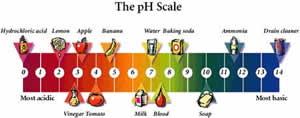 |
| http://www.differencebetween.info/sites/default/files/images/1/ph-scale.jpg |
S&EP - SP7: Engaging in argument from evidence
I used evidence to defend my explanation. I conducted an experiment that tested the pH level of different acidic or basic products and filled out a worksheet about the pH level of acids and bases, providing the results of the experiment as evidence. I formulated evidence based on solid data when I stated that the more red the substance was when it was tested, the more concentrated the acid was using my observation that the lower the numbers got on the pH scale, the more red the substance had to be and the lower the pH level of a substance means that the substance is a stronger acid, as evidence. I examined my own understanding in light of the evidence. I used to think that when a substance had a pH level of 7, it just meant the substance was in between and was both an acid and a base, but because of learning about neutral substances now I think that when the pH level of a substance is 7 that means that it is neither an acid or a base, but a neutral substance. I collaborated with my peers in searching for the best explanation. I did some research on how to use a pH scale to tell if a substance is an acid or a base which I discussed with my class and the people at my table who conducted the experiment with me. Together we figured out that the lower the pH level and the more red a substance is, the more acidic the substance is. As well as the higher the pH level and the more green or blue a substance is, the more basic the substance.
XCC: Patterns
The pattern that occurs with using a pH scale to measure if a substance is acidic or basic, deals with the pH level of the substance and what color it is when tested. I observed this pattern when conducting an experiment in class that allowed me to see how acidic or basic a substance was based on its pH level. During the experiment I saw that after testing out the substances, all the acid products were a pink to reddish color and all of the base products were a green to blue color. When testing an acid product, I noticed that the more red the substance, the lower the pH level of the substance. Which lead me to figure out the the lower the pH level of a substance, the stronger and more concentrated the acid is. As well as the higher the pH level of an acid, the weaker and less concentrated the acid is. In contrast, I noticed an opposite pattern with bases. When testing a base product, I noticed that the more green the substance got, the higher the pH level of the substance on a pH scale. With this information I found that the higher the pH level of a substance, the more concentrated and stronger the base is. In addition, the lower the pH level of a base, the less concentrated and weak the base is.
No comments:
Post a Comment